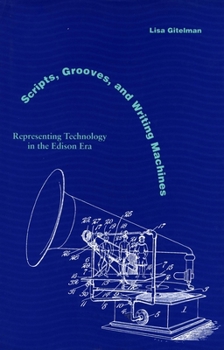Scripts, Grooves, and Writing Machines: Representing Technology in the Edison Era
Select Format
Select Condition 
Book Overview
This is a richly imaginative study of machines for writing and reading at the end of the nineteenth century in America. Its aim is to explore writing and reading as culturally contingent experiences, and at the same time to broaden our view of the relationship between technology and textuality. At the book's heart is the proposition that technologies of inscription are materialized theories of language. Whether they failed (like Thomas Edison's...
Format:Paperback
Language:English
ISBN:0804738726
ISBN13:9780804738729
Release Date:January 2000
Publisher:Stanford University Press
Length:304 Pages
Weight:1.06 lbs.
Dimensions:0.7" x 5.5" x 8.5"
Customer Reviews
1 rating
Lively media connections
Published by Thriftbooks.com User , 24 years ago
This extraordinary book makes startling, illuminating, and elegant connections between what seem to be unrelated events and objects, and thereby shifts how we can understand changes in media from the mid nineteenth century into the present. It is beautifully written, and witty and erudite besides. Gitelman has a great ability to synthesize without reducing complexity. Instead she encompasses disregarded aspects of a situation to open up unexpected connections. I loved the way connections she makes open up whole different ways of seeing things. So her examination of shorthand as a precursor to the phonograph allows us to understand the phonograph as Edison did, as a machine for writing and reading. Then she goes on to convincingly links this shorthand/phonograph discussion to larger and still current issues of standardization, both of technical devices and operating systems, and of spelling. Other connections go further. The final section of the book, "Coda: The (Hyper)textualization of Everyday Life," for example, critiques the dominant accounts of hypertext and reading and writing associated with computing for ignoring a "prehistory of computing" beyond calculating devices. She suggests including the elaborate search and retrieval architecture of the New York Public Library or the "integrated structure and semiotics of Grand Central Station...with its routes and signals for trains, its routes and signals for passengers, and the tiny spiral staircase that connects an information booth on one level (suburban transit) with an information booth on the other (interurban)." Gitelman thinks both largely and in meticulously informed detail about important issues that are embedded in our everyday lives, the media we use, and in history. This book is an eyeopener and a lively read.





